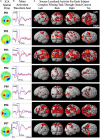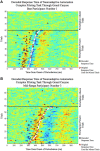The Brain Is Faster than the Hand in Split-Second Intentions to Respond to an Impending Hazard: A Simulation of Neuroadaptive Automation to Speed Recovery to Perturbation in Flight Attitude
- PMID: 27199710
- PMCID: PMC4846799
- DOI: 10.3389/fnhum.2016.00187
The Brain Is Faster than the Hand in Split-Second Intentions to Respond to an Impending Hazard: A Simulation of Neuroadaptive Automation to Speed Recovery to Perturbation in Flight Attitude
Abstract
The goal of this research is to test the potential for neuroadaptive automation to improve response speed to a hazardous event by using a brain-computer interface (BCI) to decode perceptual-motor intention. Seven participants underwent four experimental sessions while measuring brain activity with magnetoencephalograpy. The first three sessions were of a simple constrained task in which the participant was to pull back on the control stick to recover from a perturbation in attitude in one condition and to passively observe the perturbation in the other condition. The fourth session consisted of having to recover from a perturbation in attitude while piloting the plane through the Grand Canyon constantly maneuvering to track over the river below. Independent component analysis was used on the first two sessions to extract artifacts and find an event related component associated with the onset of the perturbation. These two sessions were used to train a decoder to classify trials in which the participant recovered from the perturbation (motor intention) vs. just passively viewing the perturbation. The BCI-decoder was tested on the third session of the same simple task and found to be able to significantly distinguish motor intention trials from passive viewing trials (mean = 69.8%). The same BCI-decoder was then used to test the fourth session on the complex task. The BCI-decoder significantly classified perturbation from no perturbation trials (73.3%) with a significant time savings of 72.3 ms (Original response time of 425.0-352.7 ms for BCI-decoder). The BCI-decoder model of the best subject was shown to generalize for both performance and time savings to the other subjects. The results of our off-line open loop simulation demonstrate that BCI based neuroadaptive automation has the potential to decode motor intention faster than manual control in response to a hazardous perturbation in flight attitude while ignoring ongoing motor and visual induced activity related to piloting the airplane.
Keywords: MEG; aviation; brain computer interface; brain machine interface; decoding; independent component analysis; neuroadaptive automation; neuroergonomics.
Figures





Similar articles
-
A Characterization of Brain-Computer Interface Performance Trade-Offs Using Support Vector Machines and Deep Neural Networks to Decode Movement Intent.Front Neurosci. 2018 Oct 24;12:763. doi: 10.3389/fnins.2018.00763. eCollection 2018. Front Neurosci. 2018. PMID: 30459542 Free PMC article.
-
Training in Use of Brain-Machine Interface-Controlled Robotic Hand Improves Accuracy Decoding Two Types of Hand Movements.Front Neurosci. 2018 Jul 11;12:478. doi: 10.3389/fnins.2018.00478. eCollection 2018. Front Neurosci. 2018. PMID: 30050405 Free PMC article.
-
Flight simulation using a Brain-Computer Interface: A pilot, pilot study.Exp Neurol. 2017 Jan;287(Pt 4):473-478. doi: 10.1016/j.expneurol.2016.05.013. Epub 2016 May 16. Exp Neurol. 2017. PMID: 27196543
-
Dual Passive Reactive Brain-Computer Interface: A Novel Approach to Human-Machine Symbiosis.Front Neuroergon. 2022 Apr 11;3:824780. doi: 10.3389/fnrgo.2022.824780. eCollection 2022. Front Neuroergon. 2022. PMID: 38235478 Free PMC article.
-
From classic motor imagery to complex movement intention decoding: The noninvasive Graz-BCI approach.Prog Brain Res. 2016;228:39-70. doi: 10.1016/bs.pbr.2016.04.017. Epub 2016 May 31. Prog Brain Res. 2016. PMID: 27590965 Review.
Cited by
-
Disruption in neural phase synchrony is related to identification of inattentional deafness in real-world setting.Hum Brain Mapp. 2018 Jun;39(6):2596-2608. doi: 10.1002/hbm.24026. Epub 2018 Feb 26. Hum Brain Mapp. 2018. PMID: 29484760 Free PMC article.
-
Electro-Encephalography and Electro-Oculography in Aeronautics: A Review Over the Last Decade (2010-2020).Front Neuroergon. 2020 Dec 21;1:606719. doi: 10.3389/fnrgo.2020.606719. eCollection 2020. Front Neuroergon. 2020. PMID: 38234309 Free PMC article. Review.
-
Simultaneous fMRI and tDCS for Enhancing Training of Flight Tasks.Brain Sci. 2023 Jul 3;13(7):1024. doi: 10.3390/brainsci13071024. Brain Sci. 2023. PMID: 37508957 Free PMC article.
-
Cerebellum, Basal Ganglia, and Cortex Mediate Performance of an Aerial Pursuit Task.Front Hum Neurosci. 2020 Feb 14;14:29. doi: 10.3389/fnhum.2020.00029. eCollection 2020. Front Hum Neurosci. 2020. PMID: 32116611 Free PMC article.
-
In silico vs. Over the Clouds: On-the-Fly Mental State Estimation of Aircraft Pilots, Using a Functional Near Infrared Spectroscopy Based Passive-BCI.Front Hum Neurosci. 2018 May 17;12:187. doi: 10.3389/fnhum.2018.00187. eCollection 2018. Front Hum Neurosci. 2018. PMID: 29867411 Free PMC article.
References
-
- Blankertz B., Schäfer C., Dornhege G., Curio G. (2002). Single trial detection of EEG error potentials: a tool for increasing BCI transmission rates, in Artificial Neural Networks—ICANN 2002 (Berlin; Heidelberg: Springer; ), 1137–1143. 10.1007/3-540-46084-5_184 - DOI
LinkOut - more resources
Full Text Sources
Other Literature Sources

